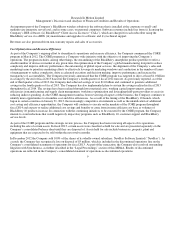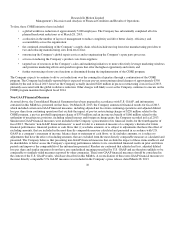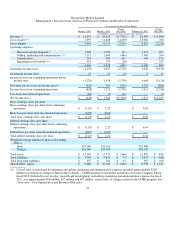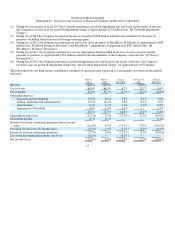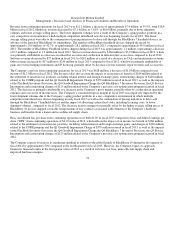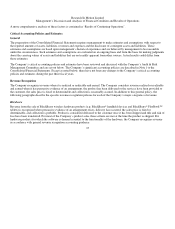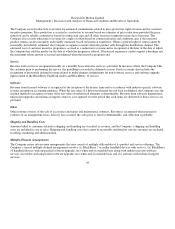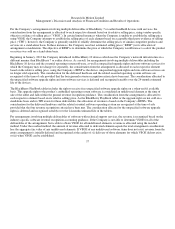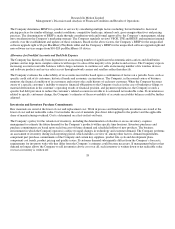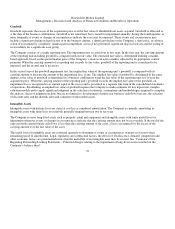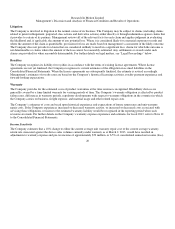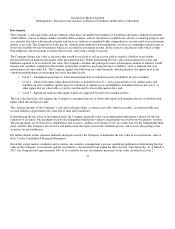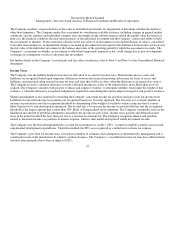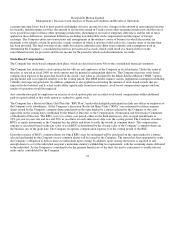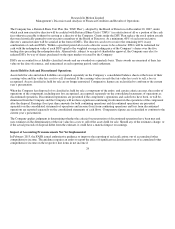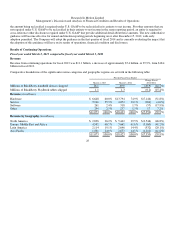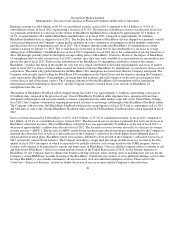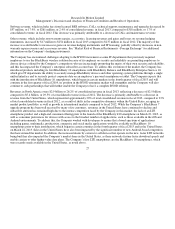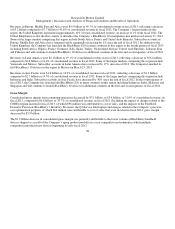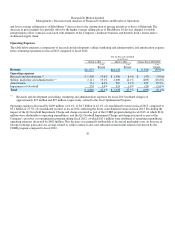Blackberry 2013 Annual Report Download - page 184
Download and view the complete annual report
Please find page 184 of the 2013 Blackberry annual report below. You can navigate through the pages in the report by either clicking on the pages listed below, or by using the keyword search tool below to find specific information within the annual report.
Research In Motion Limited
Management’s Discussion and Analysis of Financial Condition and Results of Operations
Goodwill
Goodwill represents the excess of the acquisition price over the fair value of identifiable net assets acquired. Goodwill is allocated as
at the date of the business combination. Goodwill is not amortized, but is tested for impairment annually, during the fourth quarter, or
more frequently if events or changes in circumstances indicate the asset may be impaired. These events and circumstances may
include a significant change in legal factors or in the business climate, a significant decline in the Company’s share price, an adverse
action of assessment by a regulator, unanticipated competition, a loss of key personnel, significant disposal activity and the testing of
recoverability for a significant asset group.
The Company consists of a single reporting unit. The impairment test is carried out in two steps. In the first step, the carrying amount
of the reporting unit including goodwill is compared with its fair value. The estimated fair value is determined utilizing a market-
based approach, based on the quoted market price of the Company’s stock in an active market, adjusted by an appropriate control
premium. When the carrying amount of a reporting unit exceeds its fair value, goodwill of the reporting unit is considered to be
impaired, and the second step is necessary.
In the second step of the goodwill impairment test, the implied fair value of the reporting unit’s goodwill is compared with its
carrying amount to measure the amount of the impairment loss, if any. The implied fair value of goodwill is determined in the same
manner as the value of goodwill is determined in a business combination using the fair value of the reporting unit as if it were the
acquisition price. When the carrying amount of the reporting unit’s goodwill exceeds the implied fair value of the goodwill, an
impairment loss is recognized in an amount equal to the excess and is presented as a separate line item in the consolidated statements
of operations. Establishing an implied fair value of goodwill requires the Company to make estimates for key inputs into complex
valuation models and to apply significant judgment in the selection of estimates, assumptions and methodologies required to complete
the analysis. Areas of judgment include, but are not limited to, development of multi-year business cash flow forecasts, the selection
of discount rates and the identification and valuation of unrecorded assets.
Intangible Assets
Intangible assets with definite lives are stated at cost less accumulated amortization. The Company is currently amortizing its
intangible assets with finite lives over periods generally ranging between two to ten years.
The Company reviews long-lived assets such as property, plant and equipment and intangible assets with finite useful lives for
impairment whenever events or changes in circumstances indicate that the carrying amount may not be recoverable. If the total of the
expected undiscounted future cash flows is less than the carrying amount of the asset, a loss is recognized for the excess of the
carrying amount over the fair value of the asset.
The useful lives of intangible assets are evaluated quarterly to determine if events or circumstances warrant a revision to their
remaining period of amortization. Legal, regulatory and contractual factors, the effects of obsolescence, demand, competition and
other economic factors are potential indicators that the useful life of an intangible asset may be revised. See “Cautionary Note
Regarding Forwarding-Looking Statements – Potential charges relating to the impairment of long-lived assets recorded on the
Company’s balance sheet”.
19


